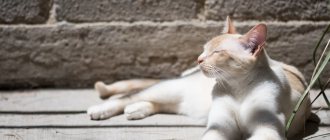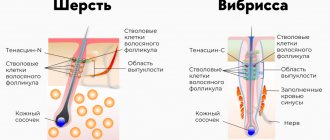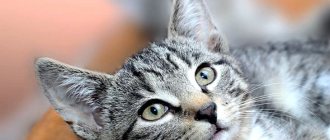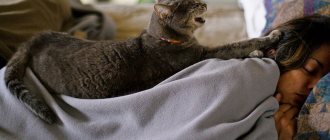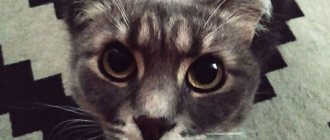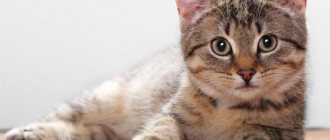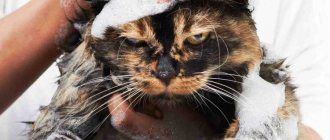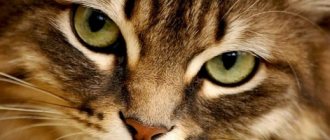Americans love to joke and smoke cigars - the combination of these two qualities helped to find an apt name for a new breed of cat. Because of their pleasant brown fur and slender, elongated body, they began to be called Havanas.
It is worth noting right away that it is difficult to buy such an animal - the breed is rare. In Russia, official clubs and nurseries do not breed it.
The breed arose from crossing Siamese and ordinary domestic cats. Siamese, like all Asian cats, have a flexible, slender body and graceful paws - this feature is also established by the standards for the Havana.
On her elongated muzzle, attention is immediately attracted by slanting eyes of bright green shades.
Havanas are not large breeds - the usual weight of a cat does not exceed 5 kg. At the same time, the muscles are well developed, the animal runs, jumps, and climbs high objects perfectly. The flexibility and grace of the cat, again, speaks of Asian roots.
The most important feature that characterizes the Havana: short fur of chocolate or lilac color, and each hair has a silver tint - creating the illusion that the coat is slightly covered with frost. A prerequisite for participation in competitions and exhibitions is a brown mustache (the same shade as the fur).
Kittens do not immediately acquire the correct coloring - babies may have spots on the body and a grayish tint to the eyes: this feature should not be considered a defect, since the green iris will form by 4 months, and the fur coat will acquire a uniform color when the animal matures.
What is the correct name for a mustache and why?
The scientific name of the mustache is vibrissae, translated from Latin, meaning “to wriggle”, “to oscillate”. If you look closely at the pet, you can see that they are really shaking. The cat's whisker follicles contain many nerve endings that capture air currents from objects and send information about the outside world to the animal's brain.
Interesting! Scientists have been able to establish that the mustaches of the ancestors of modern cats appeared earlier than the coat.
If your mustache falls out
Loss of whiskers may indicate the presence of the following problems:
1. Skin diseases. In this case, by the loss of whiskers, one can judge whether the animal has diseases such as ringworm or atopic dermatitis. 2. Fungal diseases. In this case, the affected area of the cat's skin becomes itchy and itchy. 3. The presence of parasites in the body. The coat deteriorates due to metabolic disorders, helminthic infestations, and also when infected with fleas or ticks. 4. Endocrine diseases such as hypothyroidism. If they occur, the hair becomes matted and falls out. 5. Folliculitis is inflammation of the follicles. It is caused by bacteria, fungi, and viruses.
Features of whiskers in cats
Cats' whiskers grow from birth, and their structure does not depend on the gender and breed of the animal. The only difference is the length and thickness of the hairs.
Structure
Cat whiskers have an interesting structure. Their roots are located in tissues with nerve endings approaching the hair bursa of the vibrissae. Each cat's whisker is associated with a specific part of the brain and is responsible for the functioning of a specific system.
Length
On average, cats' whiskers grow to 5-7 cm. The length of the whiskers depends on the breed of the animal. Maine Coons are considered to have the longest mustaches. A representative of this breed, nicknamed Miss, is listed in the Guinness Book of Records due to whiskers of 20 cm. But the hairless Canadian Sphynxes have short whiskers or no whiskers at all.
On a note. Cornish Rex and Devon cats have curly whiskers. This structure of the vibrissae is due to the presence of a special gene.
Thickness
The thickness of a cat's whiskers depends on the number of nerve endings, which give rise to tubercles at the very base of the whiskers. It is influenced by the sex of the animal and the location of the hairs. The female's mustache is thinner than that of the male. And the vibrissae growing on the cheeks are thicker than those located above the eyes and on the front legs.
Locations
Contrary to popular belief, cats' whiskers do not only grow on their faces. Thickened long hairs are also found on other parts of the animal's body. But they differ in quality from those located on the muzzle.
Cats' whiskers grow:
- above the eyes;
- near the nose;
- on the chin;
- around the labial pads;
- on the front legs.
The vibrissae growing on the forelimbs are almost invisible. But if you wish, you can see them just above the place where the dewclaw is located.
Causes of mustache loss
If you notice a cat's whiskers falling out, there is no need to panic. This is normal: old mustaches die off and new ones grow in their place. But if the pet suddenly began to lose whiskers, and new ones never appeared, this indicates a serious malfunction in the body.
Lack of vitamins in the body
Vibrissae begin to fall out when the cat’s diet lacks vitamins A, D, collagen and taurine, and certain microelements. With a lack of these beneficial substances, the disease can be accompanied not only by loss of whiskers, but also by hair, bad breath, and poor condition of the claws.
In this case, you need to contact a veterinarian and undergo the necessary tests to determine which vitamin is missing. Then it will be enough to change the diet and add foods rich in the vitamins the cat needs.
Lightened and falling out whiskers may indicate the presence of worms in the animal.
Thyroid problems
Disturbances in the functioning of the thyroid gland, deficiency or excess of its hormones also lead to loss of mustache. These problems are most common in older cats.
Additional symptoms are diarrhea and vomiting, constipation. If these signs are present, you should immediately contact a specialist who will prescribe a course of treatment. Self-medication will only worsen your pet's condition.
Skin diseases
Bacterial and infectious diseases can cause itching and irritation in your cat. The reason for this may be injuries, scratches, cuts.
Severe itching, weakness and loss of appetite appear.
Allergy
Due to food allergies, cats may experience hair and whisker loss. To stop this, you need to find out what product is causing your pet’s allergy and eliminate it from the diet.
If your cat has problems with its whiskers, pay attention to:
- Air humidity in a house or apartment;
- Availability of a bowl of water. Mustaches can fall out due to dehydration;
- Quality of animal feed. It must contain natural ingredients, be balanced and not have harmful additives;
- Bathing mode. It is enough to wash the cat once every 3 months;
- Hairless breeds require frequent bathing - once every two weeks in the spring and every month in the winter. The cause of mustache loss can also be the wrong shampoo;
- Time of year and puberty.
If you do not fight the loss of whiskers, this will lead to the pet becoming confused, fearful, and unable to navigate the area, even if it is an apartment in which he has lived his whole life. And on the street such a cat has a negligible chance of survival.
What functions do whiskers perform in cats?
Vibrissae perform several important functions. A cat needs whiskers to:
- Orientate yourself in space, especially at dusk. Although cats see well in weak moonlight, sensitive vibrissae help them obtain additional information about objects nearby.
- Assess the dimensions of surrounding objects and the distance to them. Before crawling under the sofa, the cat will use its whiskers to check whether it can get there.
- Explore new things, people and animals. Using its whiskers, the cat receives information about unknown objects and objects.
- Protect your eyes. When a cat makes its way through the bushes in the dark, its hard whiskers come into contact with protruding branches and it instinctively lowers its eyelids.
- Find out about weather changes. With the help of their whiskers, cats sense the slightest changes in temperature and humidity. It is believed that they anticipate the approach of natural disasters.
- Calculate the trajectory of the jump. Using its whiskers, the cat determines the speed and direction of air currents. Thanks to this, she calculates how best to jump.
- Receive information about food. The cat uses its whiskers to check the freshness and temperature of the food.
- Determine the location of the prey. Using its whiskers, the cat detects the vibrations in the air created by the mouse's escape and knows how far away it is. And the vibrissae located on the front legs allow it to control the condition of the caught prey.
What are they needed for?
Touch sensors
The whisker hairs themselves do not “feel” anything, but they vibrate. The hair follicle contains nerves that send sensory messages to the cat's brain when needed, and the whiskers serve as sensory sensors. Whiskers enhance a cat's senses and help them detect and respond to changes in their environment.
Cats use their whiskers the same way we use our fingers for touch. And just as if we lost our fingers, cats feel disoriented when navigating if they were left without their whiskers.
Measuring space and distance
By sensing vibrations, air currents and touch, cats use their whiskers to navigate. The whiskers, which are usually as long as the width of the cat's body, help the cat determine whether it will sneak into a narrow space. The cat perfectly senses how far his whiskers are tilted back so as not to get stuck in the passage into which he has stuck his head.
Whiskers also give cats the ability to visually measure distances, which is why they can leap so quickly and gracefully onto a narrow ledge or away from danger.
Cat's whisker tongue
Communication is the most important thing a cat's whiskers do. With the help of vibrissae, she gives signals by which her mood can be determined:
- If a cat's whiskers are directed forward towards the object of study, then the animal is friendly and ready to communicate.
- If a pet presses its whiskers, it means it is scared or angry. In this case, it is better to temporarily refuse to communicate with the animal, otherwise there is a risk of being harmed by its claws and teeth.
Unforeseen situation
Having figured out why a cat needs a mustache, the owners worry when they start to break off. This can happen for mechanical reasons when the cat leads an overly active lifestyle or gets into a fight. But other factors can also serve as reasons.
Vibrissae can break off due to poor quality nutrition. Calcium and other minerals especially affect their growth. If the whiskers are constantly breaking, you should reconsider the food and possibly change it.
Elasticity and strength can be affected by the presence of parasites. It is recommended to carry out preventive measures aimed at eliminating worms and fleas. If the situation has gone too far, then only a veterinarian can solve the problem.
If there are children in the house, then you need to explain to them why cats need whiskers and ask them not to deliberately break them off. Sometimes another animal, in order to show its superiority, can bully a cat and encroach on its useful decoration.
Important! Sphynx cats often lose their whiskers. If they are constantly updated and the cat looks healthy, then this is the norm, because such a situation is genetic.
Is it possible to trim a cat's whiskers?
Trimming whiskers is strictly contraindicated. Without whiskers, it will be difficult for a cat to navigate in space. She will bump into various objects and fall while jumping. Also, without whiskers, a cat will not be able to move in the dark, and will use its paws to determine the temperature of food.
An animal with damaged whiskers should not be allowed outside. Left without a mustache, the cat will become fearful, insecure and defenseless.
On a note. In rare cases, veterinarians shave cats' whiskers to enhance the therapeutic effect. This is done to treat fungal diseases and in cases where the whiskers have grown so long that they cause discomfort to the animals.
And if you cut them off
Not all breeders understand why a cat needs a mustache and try to cut it off. Some people think that this makes the cat more beautiful, others think that they disturb the pet. However, it should be understood that the whiskers are more important than the eyes. Veterinarians know of cases where blind pets were able to navigate perfectly even in an unfamiliar space, using their whiskers for this.
Therefore, if an animal's whiskers are clipped, it will suddenly become lost and may bump into objects, even during daylight hours. The fact is that a pet can only correctly estimate the distance between obstacles with the help of its whiskers. The cat looks as if it has been deprived of its sight. She may walk unsteadily, step very carefully and at the same time bump into objects.
Therefore, it is important to understand why a cat needs a mustache, and in no case to encroach on his dignity. In addition, pet communication will also be disrupted. After all, animals communicate with each other through charm, and whiskers are their main source.
Therefore, cutting a mustache for aesthetic purposes is unacceptable. Nature has intentionally endowed many animals with such decoration, and it is impossible to deprive them of such a gift for your own purposes.
